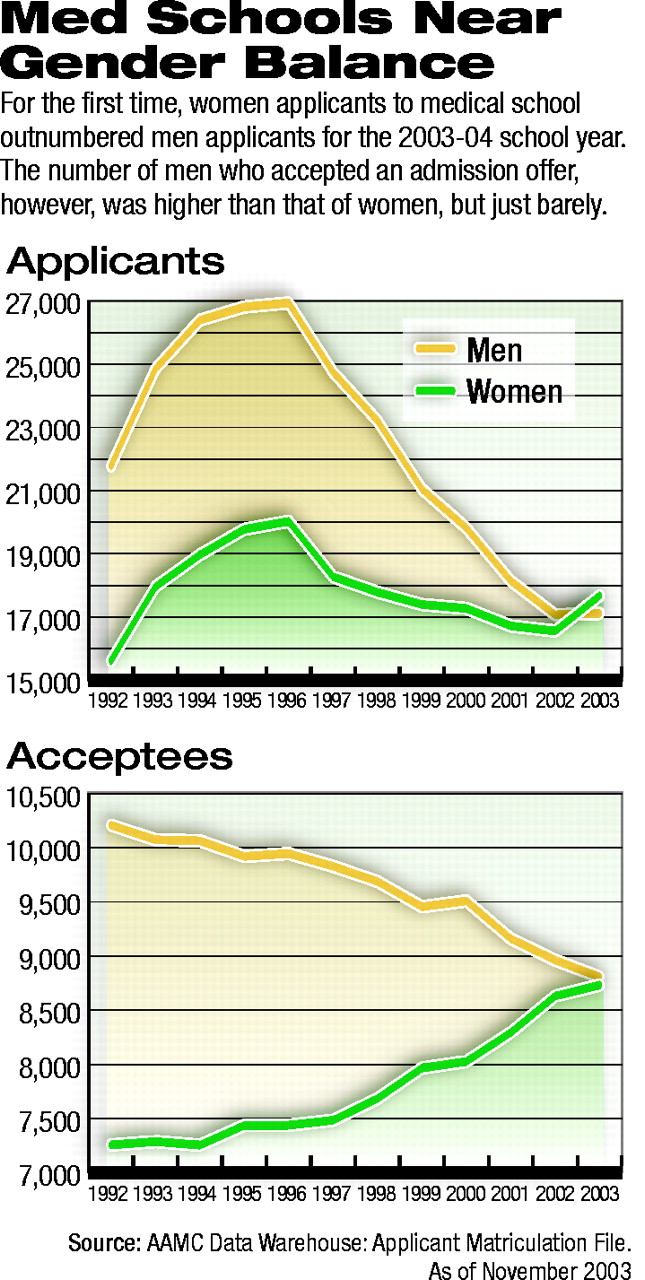
After a six-year decline, the number of applicants to U.S. medical schools is on the rise, according to data released by the Association of American Medical Colleges (AAMC).
Almost 35,000 individuals applied to attend medical school in the 2003-04 school year, a 3.4 percent increase over last year’s applicant pool of 33,625.
According to the AAMC, the main reason for the increase was the number of women applicants—17,672, an almost 7 percent rise over last year’s total. In fact, the 2003-04 school year marks the first that women have made up a majority of medical school applicants.
In addition, black women applicants increased by almost 10 percent, to 1,904, according to the AAMC.
Since 1996, when the number of individuals applying to medical school peaked at 47,000, the total number of medical school applicants has steadily dropped between 1,000 to 4,000 applicants in each subsequent year. This six-year trend reached its lowest point with last year’s total of 33,625 applicants, according to the AAMC.
APA Area 4 Trustee Sidney Weissman, M.D., an educator who has long maintained a keen interest in workforce numbers and demographics, told Psychiatric News that the two trends—an increasing number of applicants and an increasing number of women applicants—are portents to which APA leaders, educators in training programs, and physicians in general should pay attention.
“We are seeing some changes in the interest of undergraduate Americans in medicine,” he said. “One is the change in numbers, which fluctuates over time partly in response to the economy. When the economy lags and there are fewer jobs available, more people apply to medical school.”
He said the pattern goes back more than 20 years. The steep decline in the numbers of people applying to medical school in the last six years followed on the heels of the economic boom of the 1990s, for instance. But he noted that in that case, the phenomenon was also fueled by a widening perception that because of managed care and other factors, medicine was no longer the prestigious and desirable profession it once was.
The other important indicator in the AAMC numbers, Weissman said, is the increase in the number of women. “There is a significant shift in who the people are that are entering medicine,” he said. “Better than half are women. That’s important because women are more likely to enter psychiatry and child psychiatry.”
Already, he said, there are more women entering psychiatry than men. And in child psychiatry the ratio of women to men entering the field is similar to that in pediatrics. In time, he said, women will represent the majority within psychiatry, with important implications for APA leadership.
For educators, too, the shift in demographics has important implications. Training programs will need to become “women friendly,” he said, conforming schedules to the demands of childbirth and child care, as well as paternity leave for male residents.
Other statistics from this year’s application process highlighted by AAMC are the following:
• The number of black applicants overall rose almost 5 percent to 2,736—largely due to the 10 percent increase in black women applicants. But the number of blacks who were accepted and then went on to attend medical school (1,056) declined by 6 percent.
• Hispanic applicants increased by less than 2 percent to 2,483, while the number who entered medical school declined by almost 4 percent to 1,089.
• The sharp decline in the number of men applying to medical schools, a trend that started in 1997, leveled off this year. Men applicants totaled 17,113, about the same as last year’s figure of 17,069.
Because of the recent U.S. Supreme Court decisions on affirmative action, statistics on minorities underrepresented in medicine are likely to be carefully scrutinized for the next several years, the AAMC said.
“These latest figures contain both good and bad news for the medical profession,” said AAMC President Jordan J. Cohen, M.D. “The decrease in minorities entering medical school underscores the need for redoubled efforts to attract a critical mass of students from diverse backgrounds in order to enhance the education of all future physicians. At the same time, the increase in total and first-time applicants is a reaffirming sign that the current generation of young people recognizes the attractiveness of medicine as a profession.”
More information is posted online at the AAMC’s Web site at www.aamc.org/newsroom/reporter/dec03/medicalapps.htm. ▪
 After a six-year decline, the number of applicants to U.S. medical schools is on the rise, according to data released by the Association of American Medical Colleges (AAMC).
After a six-year decline, the number of applicants to U.S. medical schools is on the rise, according to data released by the Association of American Medical Colleges (AAMC).